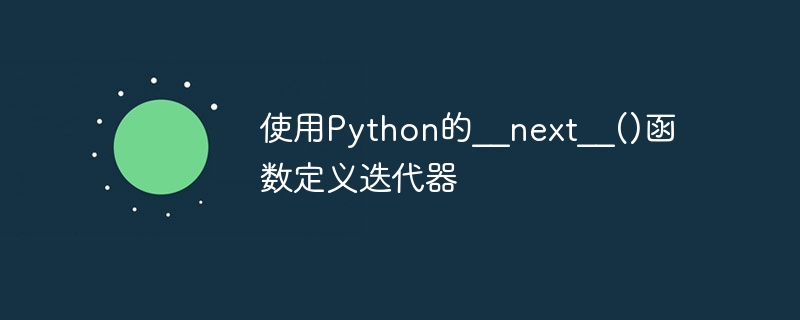Home >Backend Development >Python Tutorial >Define iterators using Python's __next__() function
Define iterators using Python's __next__() function
- WBOYWBOYWBOYWBOYWBOYWBOYWBOYWBOYWBOYWBOYWBOYWBOYWBOriginal
- 2023-08-22 10:54:271602browse

Use Python's __next__() function to define iterators
Iterator is a very important concept in Python, which allows us to access objects one by one in a loop element. Python has many built-in iterator objects, such as lists, dictionaries, and sets. However, we can also define custom iterators to meet specific needs, and the __next__() function in Python is the key to defining iterators.
__next__() function is a special function that defines the behavior of the iterator object returning elements one by one in a loop. In Python, every iterator object must contain a __next__() function, which must return the next element of the iterator. If there are no more elements to return, the __next__() function should raise a StopIteration exception.
Below we use a code example to demonstrate how to use the __next__() function to define a simple iterator:
class MyRange:
def __init__(self, start, end):
self.start = start
self.end = end
def __iter__(self):
return self
def __next__(self):
if self.start >= self.end:
raise StopIteration
else:
current = self.start
self.start += 1
return current
# 使用自定义迭代器打印1到5的数值
my_range = MyRange(1, 6)
for num in my_range:
print(num)In the above code, we define an iterator named MyRange Device class. This class accepts two parameters (start and end), which are used to specify the start value and end value of the iterator. In the __iter__() function, we return self to indicate that the class itself is an iterator. In the __next__() function, we first check whether the current value is greater than or equal to the end value. If so, a StopIteration exception is raised, indicating that there are no more elements to return. Otherwise, we save the current value, then increment the starting value by 1, and return the saved current value.
Next, we create an instance object my_range of MyRange and use it to iterate. By using a for loop to iterate over the my_range instance, each iteration calls the __next__() function of the my_range object and prints out the returned value. In the above code, we print the values from 1 to 5.
Through the above code example, we can see how to use Python's __next__() function to define a simple custom iterator. Using the __next__() function allows us to more flexibly control the iteration behavior, thereby achieving a more complex and customized iteration process.
To summarize, the __next__() function is the core part of defining an iterator, which determines how to return elements one by one in a loop. By using the __next__() function, we can customize the iterator to meet various needs, making the code more flexible and extensible. Therefore, when writing iterators, we should be familiar with and make full use of the __next__() function.
The above is the detailed content of Define iterators using Python's __next__() function. For more information, please follow other related articles on the PHP Chinese website!

